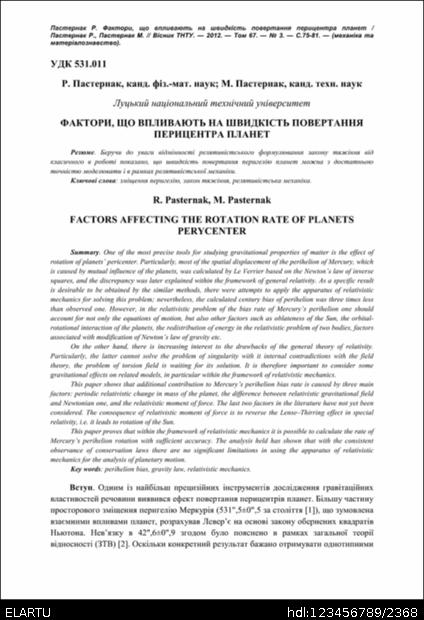Будь ласка, використовуйте цей ідентифікатор, щоб цитувати або посилатися на цей матеріал:
http://elartu.tntu.edu.ua/handle/123456789/2368

| Назва: | Фактори, що впливають на швидкість повертання перицентра планет |
| Інші назви: | Factors affecting the rotation rate of planets perycenter |
| Автори: | Пастернак, Р. Пастернак, М. Pasternak, R. Pasternak, M. |
| Бібліографічний опис: | Пастернак Р. Фактори, що впливають на швидкість повертання перицентра планет / Пастернак Р., Пастернак М. // Вісник ТНТУ. — 2012. — Том 67. — № 3. — С.75-81. — (механіка та матеріалознавство). |
| Дата публікації: | 2-лип-2012 |
| Дата внесення: | 27-чер-2013 |
| Видавництво: | Тернопільський національний технічний університет ім. Івана Пулюя |
| Місце видання, проведення: | Тернопіль, Україна |
| УДК: | 531.011 |
| Теми: | зміщення перигелію закон тяжіння релятивістська механіка perihelion bias gravity law relativistic mechanics |
| Короткий огляд (реферат): | Беручи до уваги відмінності релятивістського формулювання закону тяжіння від класичного в роботі показано, що швидкість повертання перигелію планет можна з достатньою точністю моделювати і в рамках релятивістської механіки. . One of the most precise tools for studying gravitational properties of matter is the effect of rotation of planets’ pericenter. Particularly, most of the spatial displacement of the perihelion of Mercury, which is caused by mutual influence of the planets, was calculated by Le Verrier based on the Newton’s law of inverse squares, and the discrepancy was later explained within the framework of general relativity. As a specific result is desirable to be obtained by the similar methods, there were attempts to apply the apparatus of relativistic mechanics for solving this problem; nevertheless, the calculated century bias of perihelion was three times less than observed one. However, in the relativistic problem of the bias rate of Mercury’s perihelion one should account for not only the equations of motion, but also other factors such as oblateness of the Sun, the orbital-rotational interaction of the planets, the redistribution of energy in the relativistic problem of two bodies, factors associated with modification of Newton’s law of gravity etc. On the other hand, there is increasing interest to the drawbacks of the general theory of relativity. Particularly, the latter cannot solve the problem of singularity with it internal contradictions with the field theory, the problem of torsion field is waiting for its solution. It is therefore important to consider some gravitational effects on related models, in particular within the framework of relativistic mechanics. This paper shows that additional contribution to Mercury’s perihelion bias rate is caused by three main factors: periodic relativistic change in mass of the planet, the difference between relativistic gravitational field and Newtonian one, and the relativistic moment of force. The last two factors in the literature have not yet been considered. The consequence of relativistic moment of force is to reverse the Lense–Thirring effect in special relativity, i.e. it leads to rotation of the Sun. This paper proves that within the framework of relativistic mechanics it is possible to calculate the rate of Mercury’s perihelion rotation with sufficient accuracy. The analysis held has shown that with the consistent observance of conservation laws there are no significant limitations in using the apparatus of relativistic mechanics for the analysis of planetary motion. |
| URI (Уніфікований ідентифікатор ресурсу): | http://elartu.tntu.edu.ua/handle/123456789/2368 |
| ISSN: | 1727-7108 |
| Власник авторського права: | © „Вісник Тернопільського національного технічного університету“ |
| Статус публікації : | Опубліковано раніше |
| Тип вмісту: | Article |
| Розташовується у зібраннях: | Вісник ТНТУ, 2012, № 3 (67) |
Файли цього матеріалу:
Усі матеріали в архіві електронних ресурсів захищені авторським правом, всі права збережені.